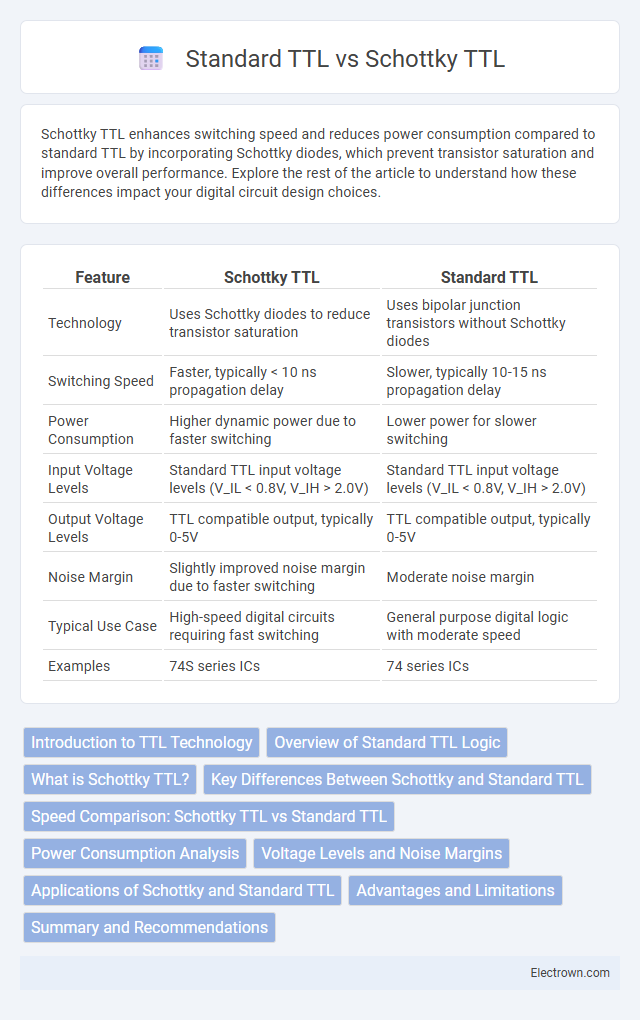Schottky TTL enhances switching speed and reduces power consumption compared to standard TTL by incorporating Schottky diodes, which prevent transistor saturation and improve overall performance. Explore the rest of the article to understand how these differences impact your digital circuit design choices.
Table of Comparison
| Feature | Schottky TTL | Standard TTL |
|---|---|---|
| Technology | Uses Schottky diodes to reduce transistor saturation | Uses bipolar junction transistors without Schottky diodes |
| Switching Speed | Faster, typically < 10 ns propagation delay | Slower, typically 10-15 ns propagation delay |
| Power Consumption | Higher dynamic power due to faster switching | Lower power for slower switching |
| Input Voltage Levels | Standard TTL input voltage levels (V_IL < 0.8V, V_IH > 2.0V) | Standard TTL input voltage levels (V_IL < 0.8V, V_IH > 2.0V) |
| Output Voltage Levels | TTL compatible output, typically 0-5V | TTL compatible output, typically 0-5V |
| Noise Margin | Slightly improved noise margin due to faster switching | Moderate noise margin |
| Typical Use Case | High-speed digital circuits requiring fast switching | General purpose digital logic with moderate speed |
| Examples | 74S series ICs | 74 series ICs |
Introduction to TTL Technology
Schottky TTL and standard TTL represent two variations of Transistor-Transistor Logic technology widely used in digital circuits. Schottky TTL improves switching speed by integrating Schottky diodes to prevent transistor saturation, enabling faster response times compared to standard TTL. Your circuits benefit from Schottky TTL's reduced propagation delay and enhanced performance in high-speed applications.
Overview of Standard TTL Logic
Standard TTL logic operates on bipolar junction transistor technology with typical switching speeds around 10 ns and power consumption ranging from 10 to 20 mW per gate. It uses a multi-transistor transistor-transistor logic configuration, providing reliable performance in a wide variety of digital circuits with a standard 0 to 5V operating voltage. Your design benefits from consistent noise margins and well-understood electrical characteristics but might face limitations in speed compared to Schottky TTL variants.
What is Schottky TTL?
Schottky TTL is a variation of standard TTL (Transistor-Transistor Logic) that incorporates Schottky diodes to reduce transistor saturation, thereby enhancing switching speed and decreasing propagation delay. By preventing transistors from entering deep saturation, Schottky TTL achieves faster operation and lower power consumption compared to standard TTL circuits. Your digital designs benefit from improved performance and efficiency when using Schottky TTL for high-speed logic applications.
Key Differences Between Schottky and Standard TTL
Schottky TTL uses Schottky diodes to reduce transistor saturation, resulting in faster switching speeds compared to standard TTL, which relies on saturation-mode transistors. The reduced storage time in Schottky TTL improves propagation delay and increases overall performance in high-speed digital circuits. In contrast, standard TTL exhibits higher power dissipation and slower response due to deeper transistor saturation.
Speed Comparison: Schottky TTL vs Standard TTL
Schottky TTL circuits operate significantly faster than standard TTL due to the incorporation of Schottky diodes that prevent transistor saturation, reducing switching delays to approximately 3-5 ns compared to 10-15 ns in standard TTL. The reduced collector storage time in Schottky TTL allows higher frequency operation and improved switching speed, making it ideal for high-speed digital applications. Standard TTL, relying on bipolar junction transistors without Schottky clamping, exhibits slower transition times and higher propagation delays, limiting its performance in time-critical circuits.
Power Consumption Analysis
Schottky TTL circuits exhibit significantly lower power consumption compared to standard TTL due to their reduced transistor saturation voltage, which minimizes switching losses and speeds up gate transitions. The use of Schottky diodes in the transistor base-emitter junction prevents deep saturation, limiting current flow and improving efficiency in high-speed logic operations. As a result, Schottky TTL devices operate with lower quiescent current and dynamic power dissipation, making them preferable for applications requiring fast switching and energy efficiency.
Voltage Levels and Noise Margins
Schottky TTL offers higher voltage levels with a typical high-level output voltage (VOH) around 3.8V compared to standard TTL's 3.4V, enhancing signal integrity in digital circuits. The increased noise margins in Schottky TTL, approximately 0.6V for both noise margin high (NMH) and noise margin low (NML), provide better immunity against voltage fluctuations and electrical noise than standard TTL's typical 0.4V noise margins. Understanding these voltage level differences and enhanced noise margins can help you optimize your circuit's reliability and performance in noisy environments.
Applications of Schottky and Standard TTL
Schottky TTL is ideal for high-speed digital circuits requiring fast switching times, such as in microprocessor control and memory systems, due to its reduced transistor saturation and lower propagation delay. Standard TTL finds widespread use in applications where speed is less critical, including basic logic gates and general-purpose digital circuits. Your choice between Schottky and Standard TTL depends on the performance needs of timing-sensitive applications versus cost-effective, lower-speed logic operations.
Advantages and Limitations
Schottky TTL offers faster switching speeds and reduced power consumption compared to standard TTL, making it ideal for high-speed digital circuits and timing-critical applications. However, Schottky TTL typically has higher manufacturing costs and slightly lower noise margins, which may limit its use in environments with significant electrical interference. Your choice between Schottky and standard TTL should consider the trade-off between speed performance and cost-effectiveness for your specific circuit requirements.
Summary and Recommendations
Schottky TTL offers faster switching speeds and lower power consumption compared to standard TTL, making it ideal for high-speed digital circuits. Standard TTL is more cost-effective and suitable for general-purpose applications with moderate speed requirements. If your project demands enhanced performance and efficiency, selecting Schottky TTL chips will provide optimal results.
Schottky TTL vs standard TTL Infographic

 electrown.com
electrown.com